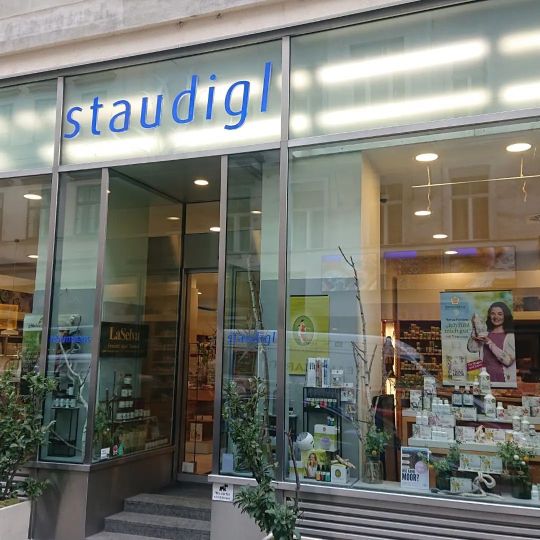#staudigl
Photo

Heute, 11.02.2023 bin ich mit meinem VITA1001 - Bio Vitalkaffee ☕ 😍 | gemahlen | 250g und NEU! in einer 100% kompostierbaren Holzfaser-Espresso-Kapsel (Nespresso kompatibel) auf Promotioneinsatz bei Reformhaus Staudigl, Wollzeile 25, A-1010 Wien. Es geht wieder los mit meinen Verkostungseinsätzen in ganz Österreich. Ich freue mich euch wieder zu sehen. Ganz neu ist nun der VITA1001 - Bio Vitalkaffee ☕ 😍 auch in einer 100% kompostierbaren Holzfaser-Espresso-Kapsel (Nespresso kompatibel)! Diese Variante gibt es absofort hier im Geschäft zu kaufen. Kommt gleich hier im Geschäft vorbei und verkostet meinen verträglichen und säurearmen VITA1001 - Bio Vitalkaffee ☕ 😍. Ich freue mich auf euren Besuch. Bis gleich, lg Gerold ☀️ ☕ 🙏 #reformhausstaudigl #staudigl #reformhaus #vita1001biovitalkaffee #derbestekaffeeindiesemuniversum #kaffeemitherzundidee #biovitalkaffee #vitalkaffee #gourmetkaffee #kaffeekapseln #nespressokompatibel #vital #kaffee #kaffeemitpilzen #kaffeemitreishi #reishikaffee #pilzkaffee #mushroomcoffee #vitalpilze #reishi #mandelpilz #kaffeeunverträglichkeit #idealbeikaffeeunverträglichkeit #bekömmlich #säurearm #basenfasten #gönndir #erfolg #biovita www.bio-vita.at https://www.instagram.com/p/CohPcjEjilp/?igshid=NGJjMDIxMWI=
#reformhausstaudigl#staudigl#reformhaus#vita1001biovitalkaffee#derbestekaffeeindiesemuniversum#kaffeemitherzundidee#biovitalkaffee#vitalkaffee#gourmetkaffee#kaffeekapseln#nespressokompatibel#vital#kaffee#kaffeemitpilzen#kaffeemitreishi#reishikaffee#pilzkaffee#mushroomcoffee#vitalpilze#reishi#mandelpilz#kaffeeunverträglichkeit#idealbeikaffeeunverträglichkeit#bekömmlich#säurearm#basenfasten#gönndir#erfolg#biovita
0 notes
Text
Interesting Papers for Week 1, 2024
Spike-based coupling between single neurons and populations across rat sensory cortices, perirhinal cortex, and hippocampus. Dorman, R., Bos, J. J., Vinck, M. A., Marchesi, P., Fiorilli, J., Lorteije, J. A. M., … Pennartz, C. M. A. (2023). Cerebral Cortex, 33(13), 8247–8264.
Value-based neural representations predict social decision preferences. Guassi Moreira, J. F., Méndez Leal, A. S., Waizman, Y. H., Tashjian, S. M., Galván, A., & Silvers, J. A. (2023). Cerebral Cortex, 33(13), 8605–8619.
Hippocampo-cortical circuits for selective memory encoding, routing, and replay. Harvey, R. E., Robinson, H. L., Liu, C., Oliva, A., & Fernandez-Ruiz, A. (2023). Neuron, 111(13), 2076-2090.e9.
Dynamic modulation of subthalamic nucleus activity facilitates adaptive behavior. Herz, D. M., Bange, M., Gonzalez-Escamilla, G., Auer, M., Muthuraman, M., Glaser, M., … Brown, P. (2023). PLOS Biology, 21(6), e3002140.
Hippocampal theta activity during encoding promotes subsequent associative memory in humans. Joensen, B. H., Bush, D., Vivekananda, U., Horner, A. J., Bisby, J. A., Diehl, B., … Burgess, N. (2023). Cerebral Cortex, 33(13), 8792–8802.
Neural reinstatement of context memory in adults with autism spectrum disorder. Justus, S. A., Mirjalili, S., Powell, P. S., & Duarte, A. (2023). Cerebral Cortex, 33(13), 8546–8556.
Not all errors are created equal: decoding the error-processing mechanisms using alpha oscillations. Li, Q., Yin, S., Wang, J., Zhang, M., Li, Z., Chen, X., & Chen, A. (2023). Cerebral Cortex, 33(13), 8110–8121.
Behavioral decomposition reveals rich encoding structure employed across neocortex in rats. Mimica, B., Tombaz, T., Battistin, C., Fuglstad, J. G., Dunn, B. A., & Whitlock, J. R. (2023). Nature Communications, 14, 3947.
A mechanism for differential control of axonal and dendritic spiking underlying learning in a cerebellum-like circuit. Muller, S. Z., Abbott, L. F., & Sawtell, N. B. (2023). Current Biology, 33(13), 2657-2667.e4.
Object-centered population coding in CA1 of the hippocampus. Nagelhus, A., Andersson, S. O., Cogno, S. G., Moser, E. I., & Moser, M.-B. (2023). Neuron, 111(13), 2091-2104.e14.
Prior expectation enhances sensorimotor behavior by modulating population tuning and subspace activity in sensory cortex. Park, J., Kim, S., Kim, H. R., & Lee, J. (2023). Science Advances, 9(27).
Cortico-ocular coupling in the service of episodic memory formation. Popov, T., & Staudigl, T. (2023). Progress in Neurobiology, 227, 102476.
Expectation violations produce error signals in mouse V1. Price, B. H., Jensen, C. M., Khoudary, A. A., & Gavornik, J. P. (2023). Cerebral Cortex, 33(13), 8803–8820.
Opponent learning with different representations in the cortico-basal ganglia pathways can develop obsession-compulsion cycle. Sato, R., Shimomura, K., & Morita, K. (2023). PLOS Computational Biology, 19(6), e1011206.
Kinematic priming of action predictions. Scaliti, E., Pullar, K., Borghini, G., Cavallo, A., Panzeri, S., & Becchio, C. (2023). Current Biology, 33(13), 2717-2727.e6.
An evolutionary conserved division-of-labor between archicortical and neocortical ripples organizes information transfer during sleep. van Schalkwijk, F. J., Weber, J., Hahn, M. A., Lendner, J. D., Inostroza, M., Lin, J. J., & Helfrich, R. F. (2023). Progress in Neurobiology, 227, 102485.
Natural statistics support a rational account of confidence biases. Webb, T. W., Miyoshi, K., So, T. Y., Rajananda, S., & Lau, H. (2023). Nature Communications, 14, 3992.
Distinct encoding and post-encoding representational formats contribute to episodic sequence memory formation. Wu, X., & Fuentemilla, L. (2023). Cerebral Cortex, 33(13), 8534–8545.
Humans predict the forest, not the trees: statistical learning of spatiotemporal structure in visual scenes. Yan, C., Ehinger, B. V, Pérez-Bellido, A., Peelen, M. V, & de Lange, F. P. (2023). Cerebral Cortex, 33(13), 8300–8311.
Fear memory recall involves hippocampal somatostatin interneurons. Zichó, K., Sos, K. E., Papp, P., Barth, A. M., Misák, E., Orosz, Á., … Nyiri, G. (2023). PLOS Biology, 21(6), e3002154.
#neuroscience#science#research#brain science#scientific publications#cognitive science#neurobiology#cognition#psychophysics#neural computation#neural networks#neurons#computational neuroscience
16 notes
·
View notes
Text
A very happy birthday to Hiroyuki Sanada! The Twilight Samurai is a personal favorite! And special thanks to Nicole Leopoldine Staudigl for the reminder, because I missed this one!










#hiroyuki sanada#the twilight samurai#bullet train#westworld#rush hour 3#avengers endgame#mortal kombat#ringu#the wolverine#life#the last samurai#47 ronin#legend of the eight samurai#message from space#the railway man#Mr. Holmes#fall guy#lost#the last ship#sunshine
142 notes
·
View notes
Text
Wien: „Demo gegen Rechts“ als pietätsloses Ablenkungsmanöver
Info-direkt:»In diesem Gastkommentar erklärt Jan Staudigl, Aktivist und Landesvorstandsmitglied der Freiheitlichen Jugend Wien, weshalb derzeit in einigen Medien viel über gewalttätige Migranten in Wien berichtet wird und weshalb Linke nicht mehr zurechnungsfähig sind: Man stelle [...]
Der Beitrag Wien: „Demo gegen Rechts“ als pietätsloses Ablenkungsmanöver erschien zuerst auf Info-DIREKT. http://dlvr.it/T4VlMP «
0 notes
Link
“Paul Ricœur’s oft-cited dictum that the history of phenomenology is a “history of heresies,” seems to apply in an extraordinary manner to the philosophy of Michel Henry. While he takes up and furthers phenomenology, he nevertheless shapes it in a way that is not only particular and critical but also quite unfamiliar. As Waldenfels has established in his well-known work on Phänomenologie in Frankreich, Henry’s philosophical approach stands out for the fact that he is beholden to few of the intuitions essential to phenomenology. That said, he ultimately pursues one that possesses enormous explosive force, namely, the insight that affectivity is the most primordial mode of revelation of both our self and the world. In the following, I would like to demonstrate the explosive force this intuition takes on when it is applied, as Henry himself has indeed done in diverse respects, to the problems of practical philosophy and in particular the critique of culture and questions of political philosophy. For I believe that the significance of Henry’s thought in no way belongs solely to the theoretical register. On the contrary, it seems to me that the force of his thought is principally discovered in its practical unfolding and application.”
2 notes
·
View notes
Text

Viele Menschen wissen nicht, wie schön es ist, dass es sie gibt. Viele Menschen wissen nicht, wie gut es uns tut, wenn wir sie sehen. Viele Menschen wissen nicht, wie uns ihr herrliches Lächeln bereichert. Viele Menschen wissen nicht, wie wohl wir uns in ihrer Nähe fühlen. Viele Menschen wissen nicht, wie arm und traurig wir ohne sie wären. Viele Menschen wissen nicht, dass sie manchmal wie Engel für uns sind. SIE WISSEN ES ERST, WENN WIR ES IHNEN SAGEN. 🦋
Christa Staudigl
35 notes
·
View notes
Link
ON CONFLICT AND VIOLENCE
Cristian Ciocan & Paul Marinescu: Introduction: On Conflict and Violence [OPEN ACCESS]
Bernhard Waldenfels: Metamorphoses of Violence (translation by Amalia Trepca)
Abstract: Based on the argument that violence has a parasitic quality rather than an essence of its own, this article seeks to bring to light the conversion processes through which violence crystallises out of, as well as into, various phenomena. Violence is first examined in terms of the relation between perpetrator and victim with, however, an emphasis on the fact that violence cannot be reduced to the intention or the act of the perpetrator. On the contrary, violence is shown to have the character of pathos and to open up a dimension of which the act itself is only a part. Further, the author argues that in being directed towards the other, violence harbours a performative contradiction: by turning the addressee into a thing to be destroyed, the addressing act cancels itself. The paper also sets out to identify the breeding grounds of violence, which, due to its capacity for conversion, can be detected in various phenomena that are not necessarily linked to violence. This means that violence can resort to various mechanisms and can emerge in multiple fields of activity: in bureaucracy, economics, medicine, politics, war, and most importantly, in everyday life, hidden under inconspicuous but sometimes pervasive forms.
Pascal Delhom: L’expérience de la violence subie : accès aux phénomènes
Abstract: There are three possible ways of access to phenomena of suffered violence: the first is the experience of those who have suffered violence themselves; the second is the experience of eyewitnesses; the third, which is the most frequent one, is an indirect access through the testimony of people belonging to the first two categories. Each way of access has advantages but also serious difficulties, both in terms of the objectivity of the experience and of the possibility to express it in language. No one is free from an affective and a normative dimension; this implies that there is a certain tension with regard to the phenomenological reduction. The paper offers an analysis of these ways of access.
James Mensch: Trust and Violence
Abstract: Jean Améry’s memoir of his imprisonment and torture by the Nazis links the loss of “trust in the world” to the violence he experienced. The loss of trust makes him feel homeless. He can no longer find a place in the intersubjective world, the world for everyone. What is this “trust in the world” (Weltvertrauen)? How does violence destroy it? In this article, I use Améry’s remarks as guide for understanding the relation of violence, trust, and homelessness. Trust, I argue, is crucial to the constitution of the intersubjective world. Violence, by undermining trust in Others, destroys the sense that this world is “for everyone.” In excluding the victim from its “for everyone,” it enforces a homelessness that transforms the victim’s very being-in-the-world.
Michael Staudigl: Parasitic Confrontations: Toward a Phenomenology of Collective Violence [OPEN ACCESS]
Abstract: This paper provides a phenomenological exploration of the phenomenon of collective violence, specifically by following the leading clue of war from Plato to the “new wars” of late globalization. It first focuses on thegenealogy of the legitimization of collective violence in terms of “counterviolence” and then demonstrates how it is mediated by constructions of “the other” in terms of “violence incarnate.” Finally, it proposes to explore such constructions—including the “barbarian” in Greek antiquity, “the cannibal” in the context of Colonialism, or the contemporary cipher of religious irrationality— as mirror effects of one’s own disavowed forms of violence.
Burkhard Liebsch: „Herrscht“ Krieg ‒ seit je her, gegenwärtig und auf immer? „Polemologische“ Überlegungen zur Frage, ob wir ihm ausgesetzt oder (auch) ausgeliefert sind
Abstract: This essay critically examines theories of war which imply an affirmation of the unavoidable rule of war. In contrast to such theories, the author advocates a notion of war that presupposes processes of becoming enemies, which eventually enthrone war as “dominating” power. From this position result a number of desiderata of research which call for a revision of actual theories of war.
Delia Popa: Entre réversibilité et réverbération. Une approche phénoménologique de la violence sociale
Abstract: How can phenomenology help address the problem of social violence? Can phenomenology provide an adequate description of its essence? Is the phenomenological method able to deepen and transform its comprehension? The paper is an attempt to answer these questions through an analysis of three different testimonies of social violence entailing elements of phenomenological description. Starting with a minimal definition of the phenomenological description, understood as search for a meaning for a lived experience and substitution with those who suffer, the article discusses several issues raised by a phenomenological description of social violence, such as the danger of justifying it when searching for its meaning, of blaming the victims who suffered from it or of prolonging its traumatizing effects. The paper ends by questioning the ways in which the phenomenological method can offer support for resilience and inspire resistance to social violence.
Irene Breuer: Phenomenological Reflections on the Intertwining of Violence, Place and Memory. The Memorials of the Ungraspable
Abstract: Acts of violence develop in relation to place and involve the violation of its very limits. Every significant place is a scene of history, its limits embrace presence and sense. As such, it is the life-worldly home of memory. In this article, I will retrieve the bodily affective dimension of the phenomenon of place memory in instances of public commemoration. Drawing on different philosophical horizons like those of mainly Heidegger, Husserl, Merleau-Ponty, Derrida, Adorno, Ricœur and Bataille, I’ll contrast their different perspectives on the question of the intertwining of violence, place and memory and refer them to the narrative work of memorials (e.g. Libeskind’s and Eisenman’s for Berlin). Insofar violence has been traditionally represented and thereby obliterated by architecture, we may ask how should genocide, as the unspeakable and ungraspable be expressed? I’ll suggest that it can only be attained by the suspension of meaning and presence: A narrative of bodily affections, of pathos, suffering and excess that accounts for what in itself remains beyond expression.
Mihai Ometiță: Hermeneutic Violence and Interpretive Conflict: Heidegger vs. Cassirer on Kant
Abstract: The paper aims to rectify the reception of Heidegger’s so-called ��hermeneutic violence,” by addressing the under-investigated issue of its actual target and rationale. Since the publication of Kant and the Problem of Metaphysics, his immediate readers, such as Cassirer, as well as more recent commentators, accused Heidegger of doing violence to Kant’s and other philosophers’ texts. I show how the rationale of Heidegger’s self-acknowledged violence becomes tenable in light of his personal notes on his Kant book, and of several hermeneutic tenets from Being and Time. The violence at stake turns out to be a genuine method, involving the appropriation (Zueignen) and the elaboration (Ausarbeiten) of an interpreted text. Its target, I argue, is not the text itself, as it was often assumed, but its reception by a community or tradition. Thus, that violence may well instill interpretive conflict, yet its purpose is to salvage a text from a conventional and ossified reception, namely, from what Heidegger regards as the authoritarianism of idle talk (Gerede) in a philosophical milieu.
Chiara Pesaresi: « L’ébranlement du monde bien connu » : Lectures croisées de Patočka et Maldiney
Abstract: The aim of this article is to analyze the idea of the event conceived as crisis and conflict in Patočka and Maldiney’s thought. The event is what tears the horizon of the meaningful world apart and opens a new world: it represents the opening of a crisis in the human existence and at the same time the condition of any future crisis to come. By reading Maldiney’s texts on the “pathique” and the psychosis along with Patočka’s descriptions of historical existence, we shall then discover that human existence is exposed (and respond) to this chaotic and conflictual dimension. In fact, what defines the existence—the individual existence (Maldiney) as well as the historical, shared existence (Patočka)—is the exposure to such a conflict and to the critical event, i.e. to the possibility of its own shaking. Furthermore, the event appears as the root of both the krisis and the “koinè”, whether it is in the form of the encounter (Maldiney) or the community cohesion (Patočka).
Jason W. Alvis: Ricœur on Violence and Religion: Or, Violence Gives Rise to Thought [OPEN ACCESS]
Abstract: This essay demonstrates Ricoeur’s explication of the various roles religion can play especially in regards to acts of collective violence, and also how his conceptions take us beyond the traditional dichotomies of religion as necessarily violent, or necessarily peaceful. It focuses on three essays where his most formidable reflections on religion and violence can be found: “Religion and Symbolic Violence” (1999), “Power and Violence” (first published 1989), and “State and Violence” (first published 1955). First, the essay hermeneutically describes the intricate relationship between violence and religion within these three essays, pointing to (i) three perils of religion especially regarding communities, (ii) the figure of the magistrate within some religiously motivated political revolutions, and (iii) the danger of ecclesiastical orders demonstrating not only authority but also forms of domination. The essay then phenomenologically ties these three threads together, demonstrating a way of understanding both the promises and perils of religion as it relates to violence, both in the work of Ricoeur and beyond it.
Michael Barber: Could the Focus on Transcendental Violence Be Violent?
Abstract: Eddo Evink criticizes Emmanuel Levinas’s supposed view that all acts of intentionality and rationality commit transcendental violence against their objects, including the Other. If this is so, Levinas undermines the possibility of his own philosophy. Evink further argues: that there are non-violent forms of intentionality and so intentionality is only potentially violent; that some non-violent counter-pole is needed to define violence; that there are contradictions in Levinas’s notion of violence; that Levinas, like empiricists, aspires to a metaphysical absolute untainted by language; and that he presupposes the philosophical, ontological, and linguistic frameworks he criticizes. However, to answer these objections, one must understand Levinas as developing two distinct modalities of relationship: Being and Otherwise than Being. These modalities clash in the face-to-face relationship when the phenomenon of the face defects into responsibility for the Other. The epistemology and ontology of Being involve distinctive acts, affects, forms of temporality, and experiences of self that undergo a tectonic shift in confrontation with the ethically obligating Other. Here the focus is not on the violence of concepts ever seeking to subjugate the Other but rather on the Other whose summons both provokes knowledge to retreat and is able to be shown in a philosophy, even if that philosophy betrays the saying in the said while also having the potential to reduce that betrayal. The focus should not be on transcendental violence tracking down and cornering the Other but on the Other ethically disrupting Being. With that focus, it becomes clear that concentrating on transcendental violence is a kind of violence.
Leonard Lawlor: The Most Difficult Task: On the Idea of an Impure, Pure Non-Violence (in Derrida)
Abstract: This article attempts to elaborate on the Derridean idea of transcendental violence and his idea of “violence against violence.” It does this by examining the structure of the gift as Derrida presents it in Given Time. The article lays out in detail all of the conditions for the gift Derrida presents across Given Time. More precisely, it examines Derrida’s analysis of the giving of counterfeit money. The conclusion it draws is that the giving of counterfeit money comes closest to the golden mean between exchange and non-exchange (or pure gift-giving), the golden mean between violence and non-violence. But the open question is: should we prescribe the giving of counterfeit money for all gift-giving and even for human relations of friendship and love?
VARIA
Mădălina Guzun: Briser le silence : Le déploiement de la langue comme traduction du silence en son chez Martin Heidegger
Abstract: The aim of the present article is to offer a new interpretation of Heidegger’s account of the unfolding of language by analyzing the notion of Geläut der Stille, “sounding gathering of silence.” Taking as a starting point the experience of silence described by Stefan George in his poem “The Word,” the article presents the opposition between silence and the sounding words, showing that the latter coincide with the language we speak. The passage from silence to the spoken language belongs to the unfolding of language itself, which presents itself as a translation of silence, redefining thus what translation originally is. The latter, understood as violence and harmony, gathers itself under the term of “rift,” overcoming thus the ontological difference and offering us a radically new perspective over the nature of “relation” within Heidegger’s thinking.
Max Schaefer: Bonds of Trust: Thinking the Limits of Reciprocity with Heidegger and Michel Henry
Abstract: This paper seeks to address whether human life harbours the possibility of a gratuitous or non-reciprocal form of trust. To address this issue, I take up Descartes’ account of the cogito as the essence of all appearing. With his interpretation of Descartes’ account of the cogito as an immanent and affective mode of appearing, I maintain that Henry provides the transcendental foundation for a non-reciprocal form of trust, which the history of Western philosophy has largely covered over by forgetting this aspect of Descartes’ thought. I demonstrate that Heidegger’s reading of Descartes serves as a pre-eminent example of this. Because Heidegger overlooks Descartes’ insight into the essence of appearing, and reduces this essence to the finite transcendence of the world, I maintain that Heidegger reduces trust to reciprocal relations of understanding between beings of shared contexts of significance.
Ahmet Süner: The Ineluctable Sign in Sartre’s Account of Franconay’s Imitation
Abstract: The most interesting example of all the physical images that Sartre examines in L’Imaginaire concerns a female performer’s (Franconay’s) imitation of a male performer (Chevalier). The example is a unique instance in which Sartre deals explicitly with the possibility of ambiguity and hybridity in consciousness. Sartre’s introduction of the sign into the consciousness of imitation ties the perception of Franconay with the imaged Chevalier, but it also leads to the dissemination of the sign across the entire consciousness, a consequence that runs against Sartre’s analytic tendencies. I argue that, despite Sartre’s endeavor to keep the sign separate from perception and the image, the sign is a diffuse property of the entire consciousness of imitation, penetrating and contaminating its every instant. Sartre’s account of Franconay’s imitation contains the germs of the destruction of his clear-cut analytic distinctions, revealing the irreducible hybridity of the sign with both perception and the image.
Mathieu Cochereau: La Dissidence et l’unité des trois mouvements de l’existence chez Jan Patočka
Abstract: Jan Patočka is usually connected with Czech dissidence, a political movement which stood up against the communist government. We want to make the hypothesis that the notion of dissidence is not originally a political one but a phenomenological one above all. Dissidence is a movement of distancing which implies a rootedness and this movement of distancing is peculiar to human beings. Patočka calls “movement of human existence” this paradoxical rootedness which is a extramundane and mundane position. Thus, we have to review the theory of the three movements of human existence. While it is tempting to separate the third movement, as a movement of transcendence, and to describe it as a political dissidence, we would like to show that the three movements (and not only the third), the existence as a movement, have to be read as a Dissidence.
BOOK REVIEWS
Erik Norman Dzwiza-Ohlsen: Hans Blumenberg, Phänomenologische Schriften. 1981–1988 (Berlin: Suhrkamp, 2018)
Alexandru Bejinariu: Alexander Schnell, Was ist Phänomenologie? (Frankfurt a. Main: Vittorio Klostermann, 2019)
Christian Ferencz-Flatz: Nicolas De Warren & Thomas Vongehr (eds), Philosophers at the Front. Phenomenology and the First World War (Leuven: Leuven University Press, 2017)
Mihaela-Cătălina Condruz: Mark Vorobej, The concept of violence (New York: Routledge, 2016)
Delia Popa: Claire Marin, Rupture(s) (Paris: L’édition de L’Observatoire/La relève, 2019)
1 note
·
View note
Photo

Irgendwie werde ich auch am Wochenende schon früher wach. Wahrscheinlich hormonell bedingt durch die Schwangerschaft.🤰 Da brauch ich morgens mein frisch nach Rose duftendes Serum von @logona_naturkosmetik Ich öle meinen Bauch immer morgens und abends ein, damit er auch bestimmt nicht nicht reisst...😒 Aber Hauptsache dem Mäusespeck geht es gut 🐭🥓 Wird wohl ein Tag mit Buch und Duftkerze daheim. Was habt ihr noch am grauen Sonntag so vor? 🍁🍂 |*PR-Sample #naturalcosmetics #organic #organiccosmetic #vegan #crueltyfree #Naturkosmetik #bio #logona #serum #oskia #nailberry #staudigl (hier: Staudigl Wien) https://www.instagram.com/p/BpePdXfAflv/?utm_source=ig_tumblr_share&igshid=xaiemty5ysj3
#naturalcosmetics#organic#organiccosmetic#vegan#crueltyfree#naturkosmetik#bio#logona#serum#oskia#nailberry#staudigl
0 notes
Photo

Heute, 17.11.2022, bin ich mit meinem VITA1001 - Bio Vitalkaffee ☕ 😍 | gemahlen | 250g und NEU! diesen in einer 10er Box mit 100% kompostierbaren Holzfaser-Espresso-Kapseln (Nespresso kompatibel) auf Promotioneinsatz in der Drogerie & Kosmetik Isabella, Gaaler Straße 2, A-8720 Knittelfeld. Ganz neu ist nun der VITA1001 - Bio Vitalkaffee ☕ 😍 auch in einer 100% kompostierbaren Holzfaser-Espresso-Kapsel (Nespresso kompatibel)! Diese Variante gibt es absofort hier im Geschäft zu kaufen. Der VITA1001 - Bio Vitalkaffee ist wohl der geschmackvollste Reishi-Kaffee in diesem Universum 🌌! Einfach ausprobieren und genießen. Kommt gleich hier im Geschäft vorbei und verkostet meinen verträglichen und säurearmen VITA1001 - Bio Vitalkaffee ☕ 😍. Ich freue mich auf euren Besuch. Bis gleich, lg Gerold ☀️ ☕ 🙏 #reformhausstaudigl #staudigl #reformhaus #drogerie #vita1001biovitalkaffee #derbestekaffeeindiesemuniversum #kaffeemitherzundidee #biovitalkaffee #vitalkaffee #gourmetkaffee #kaffeekapseln #nespressokompatibel #vital #kaffee #kaffeemitpilzen #kaffeemitreishi #reishikaffee #pilzkaffee #mushroomcoffee #vitalpilze #reishi #mandelpilz #kaffeeunverträglichkeit #idealbeikaffeeunverträglichkeit #bekömmlich #säurearm #basenfasten #gönndir #erfolg #biovita www.bio-vita.at https://www.instagram.com/p/ClJAIBnK4eH/?igshid=NGJjMDIxMWI=
#reformhausstaudigl#staudigl#reformhaus#drogerie#vita1001biovitalkaffee#derbestekaffeeindiesemuniversum#kaffeemitherzundidee#biovitalkaffee#vitalkaffee#gourmetkaffee#kaffeekapseln#nespressokompatibel#vital#kaffee#kaffeemitpilzen#kaffeemitreishi#reishikaffee#pilzkaffee#mushroomcoffee#vitalpilze#reishi#mandelpilz#kaffeeunverträglichkeit#idealbeikaffeeunverträglichkeit#bekömmlich#säurearm#basenfasten#gönndir#erfolg#biovita
0 notes
Text
Interesting Papers for Week 36, 2022
Coding of chromatic spatial contrast by macaque V1 neurons. De, A., & Horwitz, G. D. (2022). eLife, 11, e68133.
Neural Encoding of Active Multi-Sensing Enhances Perceptual Decision-Making via a Synergistic Cross-Modal Interaction. Delis, I., Ince, R. A. A., Sajda, P., & Wang, Q. (2022). Journal of Neuroscience, 42(11), 2344–2355.
Brain-like functional specialization emerges spontaneously in deep neural networks. Dobs, K., Martinez, J., Kell, A. J. E., & Kanwisher, N. (2022). Science Advances, 8(11), eabl8913.
Stimulus dependence of directed information exchange between cortical layers in macaque V1. Gieselmann, M. A., & Thiele, A. (2022). eLife, 11, e62949.
Acceleration of information processing en route to perceptual awareness in infancy. Hochmann, J.-R., & Kouider, S. (2022). Current Biology, 32(5), 1206-1210.e3.
Complementary roles of serotonergic and cholinergic systems in decisions about when to act. Khalighinejad, N., Manohar, S., Husain, M., & Rushworth, M. F. S. (2022). Current Biology, 32(5), 1150-1162.e7.
Cerebellar modulation of memory encoding in the periaqueductal grey and fear behaviour. Lawrenson, C., Paci, E., Pickford, J., Drake, R. A., Lumb, B. M., & Apps, R. (2022). eLife, 11, e76278.
The role of state uncertainty in the dynamics of dopamine. Mikhael, J. G., Kim, H. R., Uchida, N., & Gershman, S. J. (2022). Current Biology, 32(5), 1077-1087.e9.
Neurons in the Monkey’s Subthalamic Nucleus Differentially Encode Motivation and Effort. Nougaret, S., Baunez, C., & Ravel, S. (2022). Journal of Neuroscience, 42(12), 2539–2551.
Compartment-specific tuning of dendritic feature selectivity by intracellular Ca 2+ release. O’Hare, J. K., Gonzalez, K. C., Herrlinger, S. A., Hirabayashi, Y., Hewitt, V. L., Blockus, H., … Losonczy, A. (2022). Science, 375(6586).
Closed-loop neuromodulation for studying spontaneous activity and causality. Ramot, M., & Martin, A. (2022). Trends in Cognitive Sciences, 26(4), 290–299.
Adaptive Learning through Temporal Dynamics of State Representation. Razmi, N., & Nassar, M. R. (2022). Journal of Neuroscience, 42(12), 2524–2538.
Reorganization of CA1 dendritic dynamics by hippocampal sharp-wave ripples during learning. Rolotti, S. V., Blockus, H., Sparks, F. T., Priestley, J. B., & Losonczy, A. (2022). Neuron, 110(6), 977-991.e4.
Statistical learning as a reference point for memory distortions: Swap and shift errors. Scotti, P. S., Hong, Y., Golomb, J. D., & Leber, A. B. (2021). Attention, Perception, & Psychophysics, 83(4), 1652–1672.
Humans perseverate on punishment avoidance goals in multigoal reinforcement learning. Sharp, P. B., Russek, E. M., Huys, Q. J., Dolan, R. J., & Eldar, E. (2022). eLife, 11, e74402.
Saccade-related neural communication in the human medial temporal lobe is modulated by the social relevance of stimuli. Staudigl, T., Minxha, J., Mamelak, A. N., Gothard, K. M., & Rutishauser, U. (2022). Science Advances, 8(11), eabl6037.
Fast and slow feedforward inhibitory circuits for cortical odor processing. Suzuki, N., Tantirigama, M. L., Aung, K. P., Huang, H. H., & Bekkers, J. M. (2022). eLife, 11, e73406.
Deep brain stimulation of the thalamus restores signatures of consciousness in a nonhuman primate model. Tasserie, J., Uhrig, L., Sitt, J. D., Manasova, D., Dupont, M., Dehaene, S., & Jarraya, B. (2022). Science Advances, 8(11), eabl5547.
Striatal dopamine signals are region specific and temporally stable across action-sequence habit formation. van Elzelingen, W., Warnaar, P., Matos, J., Bastet, W., Jonkman, R., Smulders, D., … Willuhn, I. (2022). Current Biology, 32(5), 1163-1174.e6.
Directional Tuning of Phase Precession Properties in the Hippocampus. Yiu, Y.-H., Leutgeb, J. K., & Leibold, C. (2022). Journal of Neuroscience, 42(11), 2282–2297.
#science#Neuroscience#computational neuroscience#Brain science#research#cognition#cognitive science#psychophysics#neurons#neurobiology#neural networks#neural computation#scientific publications
7 notes
·
View notes
Photo

ドイツのポリシリコンメーカーは1,000人の雇用を削減する Wacker Chemieは、特にドイツの拠点に影響を与えるレイオフを設定して、再構築プログラムの第一歩を踏み出しました。 化学会社のポリシリコン事業の業績不振が危機の主な原因です。 同社は、生産の役割で直接働くスタッフ間の冗長性を避けたいと述べた。 ワッカーケミーAG pv magazineドイツより。 ミュンヘンに本拠を置く化学グループWacker Chemie AGは、年間2億5,000万ユーロの節約を目指しており、2022年末までに1,000人の雇用が失われることを発表することにより、「Shaping the Future」再編計画を開始しました。 同社は、約800のポストが管理サイトのスタッフと危険にさらされている間接的および非運用的役割で働く人々とともにドイツのサイトでされると発表しました。 可能な限り、人員削減は、退職、部分退職制度、または解雇契約によって実現されると、製造スタッフ間の冗長性を避けたいと強調した。 厳しいペース 最高人事責任者のクリスチャン・ハーテルは、「良い公正な解決策」は従業員代表と交渉できると確信していると語った。 Wackerは世界中で約14,500人の従業員を雇用しており、そのうち10,000人はドイツを拠点としています。 WackerのボスであるRudolf Staudigl氏は、同社は「ポリシリコン事業と化学部門の両方の競争において、より厳しいペースで進む準備をしている」と語った。 先月Wackerが発表した2019年の年次数値は、同社のポリシリコン部門に関連する評価減後の大きな損失を示しています。 https://www.pv-magazine.com/2020/02/20/german-polysilicon-maker-will-cut-1000-jobs/ #太陽光発電 #hikarakuyho #ドイツ https://www.instagram.com/p/B8zh9I0g4m3/?igshid=6jeyjquyzl4t
0 notes
Text
March 18 in Music History
1657 Birth of composer Giuseppe Ottavio Pitoni.
1734 Birth of composer Joseph Schmitt.
1756 Birth of composer Johann Christoph Vogel.
1781 Birth of composer Gustave Vogt.
1814 Birth of soprano Caroline Grünbaum in Prague.
1818 Birth of soprano Maria Nau in New York.
1831 Birth of tenor Jose Dupuis in Liege.
1844 Birth of Russian composer Nikolai Rimsky-Korsakov in Tikhvin.
1850 Birth of baritone Josef Staudigl in Vienna.
1866 Birth of composer Dumitru Kiriac-Georgescu.
1870 Birth of composer Frank Hoyt Losey.
1876 Birth of mezzo-soprano Liva Järnefelt in Vanersborg.
1881 Birth of French composer and music critic Paul le Flem in Paris.
1882 Birth of Italian composer Gian Francesco Malipiero in Venice.
1884 Birth of Dutch-American violinist, composer, and conductor Willem Van Hoogstraten.
1884 Death of soprano Anne Bishop.
1886 Birth of German tenor Rudolf Laubenthal.
1888 Birth of tenor Louis Graveure in London.
1898 Birth of composer Otto Jochum.
1889 Birth of Russian-American pianist Alexander Borovsky in Latvia.
1898 Birth of soprano Ofelia Nieto in Santiago di Compostela.
1901 Birth of composer Piotr Perkowski.
1902 FP of Arnold Schoenberg's Verklarte Nacht for string sextet in Vienna.
1904 FP of Anatole Liadov's symphonic poem Baba Yaga in St. Petersburg.
1905 Birth of American pianist John Kirkpatrick in NYC.
1909 Birth of composer Ljubica Maric.
1914 Birth of composer Cesar Guerra Peixe.
1916 Birth of composer Louis Toebosch.
1923 FP of Anton Bruckner's Study Symphony in F minor in Klosternenberg, Germany.
1925 Birth of baritone Jean-Christoph Benoit in Strasbourg.
1929 Birth of bass John Macurdy in Detroit, Mich.
1929 Birth of soprano Lotte Rysanek.
1929 Birth of composer Ctirad Kohoutek.
1930 Birth of American conductor Maurice Peress in NYC.
1937 Death of French composer Mélanie Bonis.
1940 Death of soprano Lola Beeth.
1943 Birth of Japanese violist Nobuko Imai.
1944 Birth of English Opera administrator Nicholas Snowman.
1947 Death of Dutch composer Willem Pijper. b-8 SEP 1894.
1949 FP of Peter Mennin's Symphony No. 4 The Cycle in NYC.
1950 Birth of American conductor James Conlon.
1950 Birth of German bass Jan-Hendrik Rootering.
1956 Birth of Argentinian composer Eduardo Alonso-Crespo.
1957 Birth of Bulgarian composer Gheorghi Arnaoudov in Sofia, Bulgaria.
1961 Birth of Polish composer Hanna Kulenty in Biaystok, Poland.
1961 Death of soprano Mizzi Gunther.
1966 Birth of American composer Stephen Lias.
1966 Birth of American composer Donald Reid Womack.
1967 Death of mezzo-soprano Hedy Gura.
1970 Death of tenor Giordano Paltrinieri.
1970 FP of Roger Sessions' Rhapsody for orchestra, in Baltimore.
1972 Death of baritone Gunther Ambrosius.
1980 Death of American soprano Jessica Dragonette
1994 Death of American composer William Bergsma at age 72, in Seattle.
2001 FP of H. Birtwistle´s Tango for Betty dedicated music patron, Betty Freeman. Los Angeles Philharmonic, Esa-Pekka Salonen conducting.
2002 Death of tenor Gosta Winbergh.
2004 FP of Augusta Read Thomas´ Tangle. Chicago Symphony Orchestra/Robertson, in Chicago, IL.
2 notes
·
View notes
Text
WACKER schließt das 3. Quartal 2019 mit Zuwächsen bei Umsatz und EBITDA ab
New Post has been published on https://www.chemieunternehmen.com/wacker-schliesst-das-3-quartal-2019-mit-zuwaechsen-bei-umsatz-und-ebitda-ab/
WACKER schließt das 3. Quartal 2019 mit Zuwächsen bei Umsatz und EBITDA ab
WACKER hat im 3. Quartal 2019 ein EBITDA von 272,9 Mio. € erzielt. Das sind 13 Prozent mehr als im Vorjahr (241,7 Mio. €) und 30 Prozent mehr als im Vorquartal (210,7 Mio. €). Maßgeblich für diesen kräftigen Anstieg ist ein Sonderertrag. WACKER hat im September in den Herstellungskosten Versicherungsleistungen in Höhe von 112,5 Mio. € aus dem Schadensfall verbucht, der sich 2017 am Standort Charleston in den USA ereignet hatte. Bereinigt um diesen Betrag beträgt das EBITDA 160,4 Mio. € und wäre gegenüber Vorjahr um 34 Prozent sowie im Vergleich zum Vorquartal um 24 Prozent zurückgegangen. Vor allem die erheblich geringeren Durchschnittspreise für Solarsilicium, niedrigere Preise für Standardsilicone und Effekte aus Bestandsbewertungen haben die Ergebnisentwicklung im Berichtsquartal belastet. Daneben hat ein Anlagenausfall bei einem Rohstofflieferanten zu zeitweisen Einschränkungen bei der Herstellung von Polymerprodukten am Standort Burghausen geführt. Im Quartalsvergleich ist darüber hinaus zu berücksichtigen, dass WACKER im 2. Quartal erhaltene Anzahlungen in Höhe von 19,0 Mio. € aus Vertrags- und Lieferbeziehungen mit einem Solarkunden einbehalten hatte. Für die drei Monate Juli bis September 2019 ergibt sich im WACKER-Konzern einschließlich der Versicherungsleistungen eine EBITDA-Marge von 21,5 Prozent (Q3 2018: 19,4 Prozent). Ohne Versicherungsleistungen beläuft sich die EBITDA-Marge auf 12,7 Prozent. Im Vorquartal hatte sie 16,6 Prozent betragen. In den ersten neun Monaten des Geschäftsjahres summiert sich das Konzern-EBITDA einschließlich der Versicherungsleistungen auf 625,6 Mio. €. Ohne Versicherungsleistungen beläuft sich das EBITDA im Neun-Monats-Zeitraum auf 513,1 Mio. €.
Das Konzernergebnis vor Zinsen und Steuern (EBIT) ist auf Grund der oben genannten Faktoren kräftig gewachsen. Es summiert sich von Juli bis September 2019 auf 137,1 Mio. € (Q3 2018: 106,5 Mio. €). Das sind 29 Prozent mehr als vor einem Jahr und entspricht einer EBIT-Marge von 10,8 Prozent (Q3 2018: 8,6 Prozent). Gegenüber dem 2. Quartal 2019 (70,7 Mio. €) ist das EBIT um 94 Prozent gestiegen. Das Periodenergebnis des Berichtsquartals summiert sich auf 86,3 Mio. € (Q3 2018: 68,9 Mio. €) und das Ergebnis je Aktie beläuft sich auf 1,67 € (Q3 2018: 1,31 €).
Wie bereits gemeldet, hat WACKER seine Prognose für das Gesamtjahr 2019 gesenkt. WACKER erwartet den Konzernumsatz 2019 jetzt auf dem Niveau des Vorjahres (4.978,8 Mio. €). Das EBITDA wird – ohne Berücksichtigung der Versicherungsleistungen – voraussichtlich um etwa 30 Prozent unter dem Vorjahreswert (930,0 Mio. €) liegen und das Jahresergebnis soll leicht positiv sein.
„Trotz der zunehmend schwierigeren Rahmenbedingungen hat WACKER im abgelaufenen Quartal seinen Umsatz im Jahresvergleich weiter ausgebaut und auch den Wert des Vorquartals wieder erreicht“, sagte Konzernchef Rudolf Staudigl am Donnerstag in München. „Angesichts der weltweit immer schwächer werdenden Konjunktur ist das eine durchaus respektable Leistung. Nicht zufrieden sind wir jedoch mit der Ertragsentwicklung. Zwar konnten wir auf Grund eines Sonderertrags unser Ergebnis im 3. Quartal kräftig steigern. Operativ allerdings ist das EBITDA sowohl gegenüber dem Vorjahr als auch im Vergleich zum Vorquartal ganz erheblich zurückgegangen. Um Ertragslage und Wettbewerbsfähigkeit wetterfest zu machen, erarbeiten wir jetzt ein umfassendes Programm. Wir wollen WACKER auch für zukünftige Herausforderungen effizienter und leistungsfähiger aufstellen und Kosten in signifikantem Umfang einsparen. Dazu werden wir in den nächsten Wochen unsere gesamte Organisation auf den Prüfstand stellen. Wir wollen herausfinden, wo wir schlanker werden, Funktionen zusammenführen, Aufgaben reduzieren und Prozesse noch besser gestalten können. Wir müssen und werden den schwieriger werdenden Rahmenbedingungen für unser Geschäft erfolgreich begegnen.“
Regionen
Im 3. Quartal 2019 ist der Konzernumsatz gegenüber dem Vorjahr mengen- bzw. währungsbedingt in fast allen Regionen gewachsen. Am kräftigsten fiel das Plus in Asien aus. Dort wuchs der Umsatz auf 461,8 Mio. €. Das sind 13 Prozent mehr als im Vorjahr (407,8 Mio. €). In der Region Amerika stieg der Umsatz um 2 Prozent auf 236,2 Mio. € (Q3 2018: 232,0 Mio. €). In Europa lag der Umsatz mit 506 Mio. € dagegen um 7 Prozent unter dem Wert des Vorjahres (542,4 Mio. €).
Investitionen und Netto-Cashflow
Die Investitionen des Konzerns beliefen sich im 3. Quartal 2019 auf 87,8 Mio. € (Q3 2018: 121,6 Mio. €). Das sind 28 Prozent weniger als vor einem Jahr. Die Mittel gingen vor allem in den Ausbau der Kapazitäten für Silicon- und Polymerprodukte.
Der Netto-Cashflow lag im 3. Quartal 2019 bei 175,7 Mio. € (Q3 2018: 4,1 Mio. €). Die wesentliche Ursache für diesen Anstieg ist der im Jahresvergleich deutlich höhere Mittelzufluss aus dem operativen Geschäft.
Mitarbeiter
Die Zahl der bei WACKER weltweit Beschäftigten ist im Berichtsquartal geringfügig zurückgegangen. Zum Stichtag 30. September 2019 waren im Konzern 14.775 (30.06.2019: 14.826) Mitarbeiterinnen und Mitarbeiter tätig. An den WACKER-Standorten in Deutschland arbeiteten zum Ende des Berichtsquartals 10.434 (30.06.2019: 10.453) Beschäftigte, an den internationalen Standorten waren es 4.341 (30.06.2019: 4.373) Mitarbeiter.
Geschäftsbereiche
WACKER SILICONES hat im 3. Quartal 2019 einen Gesamtumsatz von 633,3 Mio. € erzielt und damit das Niveau des Vorjahres (634,9 Mio. €) erreicht. Sowohl die im Jahresvergleich insgesamt etwas höheren Absatzmengen als auch Währungsveränderungen haben den Umsatz positiv beeinflusst. Preiseffekte haben den Umsatz dagegen gemindert. Im Vergleich zum Vorquartal (650,0 Mio. €) ging der Umsatz preisbedingt um drei Prozent zurück. Das EBITDA von WACKER SILICONES lag im Berichtsquartal mit 127,1 Mio. € um 27 Prozent unter Vorjahr (173,4 Mio. €). Zusätzlich zu den im Jahresvergleich geringeren Preisen für Standardsilicone haben sich Maßnahmen zur Optimierung des Working Capital im EBITDA ausgewirkt. Den Wert des Vorquartals (119,8 Mio. €) hat der Bereich dagegen um 6 Prozent übertroffen. Die EBITDAMarge belief sich im 3. Quartal 2019 auf 20,1 Prozent nach 27,3 Prozent im 3. Quartal 2018 und 18,4 Prozent im Vorquartal.
Der Gesamtumsatz von WACKER POLYMERS liegt im Berichtsquartal mit 334,8 Mio. € um 1 Prozent unter dem Wert des Vorjahres (338,8 Mio. €). Positive Währungseffekte haben die im Durchschnitt geringfügig niedrigeren Absatzmengen und Preise für Polymerprodukte nicht vollständig ausgeglichen. Im Vergleich zum Vorquartal (353,3 Mio. €) ist der Umsatz vor allem mengenbedingt um 5 Prozent zurückgegangen. WACKER POLYMERS hat im 3. Quartal 2019 ein EBITDA von 48,7 Mio. € (Vorjahr 46,9 Mio. €) erzielt. Das ist ein Plus von 4 Prozent. Vor allem die gute Kostenstruktur hat das EBITDA positiv beeinflusst. Im Vergleich zum Vorquartal (52,7 Mio. €) ist das EBITDA dagegen um 8 Prozent zurückgegangen. Hier wirkte sich unter anderem ein Anlagenausfall bei einem Rohstofflieferanten aus. Die Produktion am Standort Burghausen war dadurch zeitweise beeinträchtigt, was wiederum die Auslastung reduziert und so das EBITDA gemindert hat. Die EBITDAMarge lag im Berichtsquartal bei 14,5 Prozent nach 13,8 Prozent im Vorjahr und 14,9 Prozent im Vorquartal.
WACKER BIOSOLUTIONS erzielte im 3. Quartal 2019 einen Gesamtumsatz von 60,7 Mio. €. Das sind 6 Prozent mehr als im Vorjahr (57,3 Mio. €). Besonders gut hat sich im Berichtsquartal das Geschäft mit biopharmazeutischen Produkten entwickelt. Hier haben vor allem deutlich gesteigerte Absatzmengen den Umsatz erhöht. Währungseinflüsse wirkten sich ebenfalls positiv auf die Erlöse aus. Gegenüber dem Vorquartal (60,8 Mio. €) ist der Umsatz des Geschäftsbereichs in etwa gleich geblieben. Das EBITDA von WACKER BIOSOLUTIONS liegt im Berichtsquartal mit 7,3 Mio. € um 22 Prozent über Vorjahr (6,0 Mio. €) und entspricht dem Wert des Vorquartals (7,3 Mio. €). Neben den höheren Volumina machten sich im Jahresvergleich auch eine verbesserte Kostenstruktur und die steigende Auslastung der Biopharma-Produktion positiv bemerkbar. Die EBITDA-Marge wuchs auf 12,0 Prozent nach 10,5 Prozent im Vorjahr. Im 2. Quartal 2019 hatte die EBITDA- Marge ebenfalls 12,0 Prozent betragen.
WACKER POLYSILICON hat im Berichtsquartal einen Gesamtumsatz von 206,4 Mio. € erzielt. Das sind 19 Prozent mehr als im Vorjahr (173,5 Mio. €) und 22 Prozent mehr als im Vorquartal (169,9 Mio. €). Der wesentliche Grund für diesen Zuwachs sind stark gestiegene Absatzmengen. Die sowohl im Jahres- als auch im Quartalsvergleich niedrigeren Durchschnittspreise für Solarsilicium konnte der Geschäftsbereich dadurch mehr als ausgleichen. Das EBITDA von WACKER POLYSILICON belief sich im Berichtsquartal auf 85,1 Mio. €. Das sind 80,8 Mio. € mehr als im Vorjahr (4,3 Mio. €) und 79,4 Mio. € mehr als im Vorquartal (5,7 Mio. €). Der Grund für diesen starken Anstieg ist ein Sonderertrag. Der Geschäftsbereich hat im Berichtsquartal Versicherungsleistungen in Höhe von 112,5 Mio. € aus dem Schadensfall verbucht, der sich 2017 am Standort Charleston in den USA ereignet hatte. Operativ ist das EBITDA deutlich auf -27,4 Mio. € zurückgegangen. Zusätzlich zu den niedrigeren Durchschnittspreisen für Polysilicium haben Bestandsabwertungen das EBITDA gemindert. Von Juli bis September 2019 errechnet sich für den Geschäftsbereich eine EBITDA-Marge von 41,2 Prozent nach 2,5 Prozent im 3. Quartal 2018 und 3,4 Prozent im 2. Quartal 2019. Ohne Versicherungsleistungen beläuft sich die EBITDA-Marge des Berichtsquartals auf -13,3 Prozent.
Ausblick
Wie bereits gemeldet geht WACKER jetzt davon aus, dass wesentliche finanzielle Steuerungskennzahlen im Geschäftsjahr 2019 voraussichtlich schwächer ausfallen werden als bislang prognostiziert. Ausschlaggebend für die geringeren Erwartungen sind die nach wie vor extrem niedrigen Preise für Polysilicium. Viele Marktexperten hatten für das zweite Halbjahr fest mit einer Preiserholung bei Solarsilicium gerechnet. Diese Annahme war auch Bestandteil der bisherigen Prognose von WACKER. Bislang jedoch haben sich die Durchschnittspreise für dieses Material nicht verbessert, sondern sie sind im Gegenteil im 3. Quartal weiter zurückgegangen. Darüber hinaus bremst auch die weltweit immer schwächer werdende Konjunktur alle Geschäftsbereiche.
Im Einzelnen hat das Unternehmen jetzt folgende Erwartungen, wobei die Versicherungsleistungen aus dem Schadensfall am Standort Charleston wie bisher nicht Bestandteil der Jahresprognose sind:
Der Konzernumsatz des Geschäftsjahres 2019 wird voraussichtlich auf dem Niveau des Vorjahres liegen (bisherige Prognose: Anstieg um einen mittleren einstelligen Prozentsatz). Das EBITDA wird um etwa 30 Prozent unter dem Vorjahreswert erwartet (bisherige Prognose: 10 bis 20 Prozent unter Vorjahr). Das Jahresergebnis wird voraussichtlich leicht positiv sein (bisherige Prognose: deutlich unter Vorjahr). Der Netto-Cashflow soll deutlich positiv sein, aber unter Vorjahr liegen (bisherige Prognose: deutlich positiv und deutlich über Vorjahr).
Die EBITDA-Marge erwartet WACKER unverändert deutlich unter Vorjahr. Nicht geändert hat sich auch die Prognose für die Investitionen (rund 400 Mio. €). Die Netto-Finanzschulden werden über dem Niveau des Vorjahres erwartet, wobei der Anstieg nicht nur aus der erstmaligen Anwendung von IFRS 16, sondern auch aus dem niedrigeren Netto-Cashflow kommt. Die Abschreibungen sollen bei rund 550 Mio. € liegen und der ROCE wird voraussichtlich deutlich unter dem Niveau des Vorjahres sein.
Hinweis für die Redaktionen: Der Bericht zum 3. Quartal 2019 steht auf den Internet-Seiten von WACKER (www.wacker.com) unter Investor Relations zum Download zur Verfügung.
Die Original-Meldung zu diesem Chemie Unternehmen finden Sie unter https://www.wacker.com/cms/de/press_media/press-releases/pressinformation-detail_107456.jsp?cid=rss:press
Chemieunternehmen unter https://www.chemieunternehmen.com
0 notes
Text
Globaler Wettbewerb: Wacker-Chemie-Chef will niedrigere Strompreise
Der Chef von Wacker Chemie, Rudolf Staudigl, fordert deutlich niedrigere Strompreise für die Industrie in Deutschland, um die einheimischen Firmen im globalen Wettbewerb zu stärken. https://newsburger.de/muenchen-wacker-chemie-chef-will-niedrigere-strompreise-115122.html
0 notes


